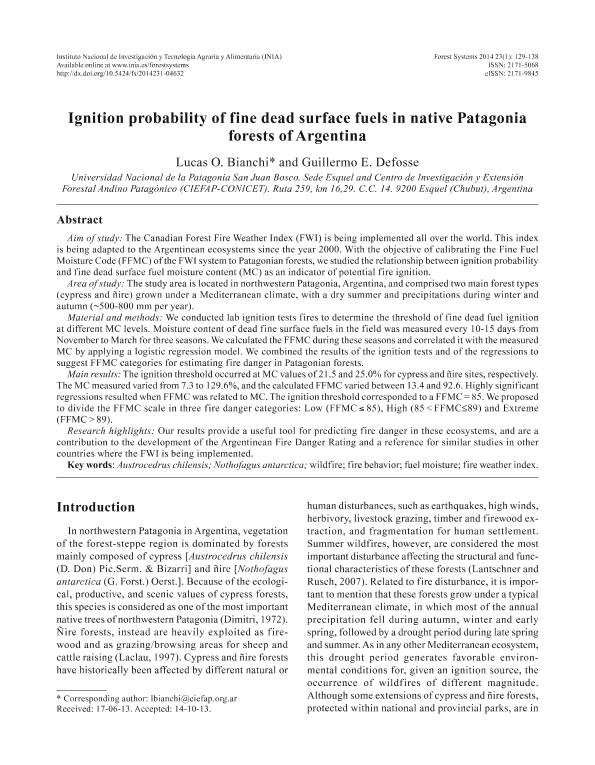Mostrar el registro sencillo del ítem
dc.contributor.author
Bianchi, Lucas Osvaldo

dc.contributor.author
Defossé, Guillermo Emilio

dc.date.available
2016-09-19T18:48:37Z
dc.date.issued
2013-11
dc.identifier.citation
Bianchi, Lucas Osvaldo; Defossé, Guillermo Emilio; Ignition probability of fine dead surface fuels in native Patagonian forests of Argentina; INIA; Forest Systems; 23; 1; 11-2013; 129-138
dc.identifier.issn
2171-5068
dc.identifier.uri
http://hdl.handle.net/11336/7651
dc.description.abstract
Aim of study: The Canadian Forest Fire Weather Index (FWI) is being implemented all over the world. This index is being adapted to the Argentinean ecosystems since the year 2000. With the objective of calibrating the Fine Fuel Moisture Code (FFMC) of the FWI system to Patagonian forests, we studied the relationship between ignition probability and fine dead surface fuel moisture content (MC) as an indicator of potential fire ignition. Area of study: The study area is located in northwestern Patagonia, Argentina, and comprised two main forest types (cypress and ñire) grown under a Mediterranean climate, with a dry summer and precipitations during winter and autumn (~500-800 mm per year). Material and Methods: We conducted lab ignition tests fires to determine the threshold of fine dead fuel ignition at different MC levels. Moisture content of dead fine surface fuels in the field was measured every 10-15 days from November to March for three seasons. We calculated the FFMC during these seasons and correlated it with the measured MC by applying a logistic regression model. We combined the results of the ignition tests and of the regressions to suggest FFMC categories for estimating fire danger in Patagonian forests. Main results: The ignition threshold occurred at MC values of 21.5 and 25.0% for cypress and ñire sites, respectively. The MC measured varied from 7.3 to 129.6%, and the calculated FFMC varied between 13.4 and 92.6. Highly significant regressions resulted when FFMC was related to MC. The ignition threshold corresponded to a FFMC=85. We proposed to divide the FFMC scale in three fire danger categories: Low (FFMC<=85), High (85<FFMC<=89) and Extreme (FFMC>89). Research highlights: Our results provide a useful tool for predicting fire danger in these ecosystems, and are a contribution to the development of the Argentinean Fire Danger Rating and a reference for similar studies in other countries where the FWI is being implemented.
dc.format
application/pdf
dc.language.iso
eng
dc.publisher
INIA
dc.rights
info:eu-repo/semantics/openAccess
dc.rights.uri
https://creativecommons.org/licenses/by-nc-sa/2.5/ar/
dc.subject
Wildfire
dc.subject
Fire Behavior
dc.subject
Fuel Moisture
dc.subject
Fire Weather Index
dc.subject
Astrocedrus Chilensis
dc.subject
Nothofagus Antarctica
dc.subject.classification
Otras Ciencias Agrícolas

dc.subject.classification
Otras Ciencias Agrícolas

dc.subject.classification
CIENCIAS AGRÍCOLAS

dc.title
Ignition probability of fine dead surface fuels in native Patagonian forests of Argentina
dc.type
info:eu-repo/semantics/article
dc.type
info:ar-repo/semantics/artículo
dc.type
info:eu-repo/semantics/publishedVersion
dc.date.updated
2016-09-14T17:37:42Z
dc.journal.volume
23
dc.journal.number
1
dc.journal.pagination
129-138
dc.journal.pais
España

dc.journal.ciudad
Madrid
dc.description.fil
Fil: Bianchi, Lucas Osvaldo. Centro de Investigación y Extensión Forestal Andino Patagónico; Argentina. Universidad Nacional de la Patagonia "San Juan Bosco"; Argentina. Consejo Nacional de Investigaciones Científicas y Técnicas; Argentina
dc.description.fil
Fil: Defossé, Guillermo Emilio. Universidad Nacional de la Patagonia "san Juan Bosco". Facultad de Ingenieria - Sede Esquel. Departamento de Ingenieria Forestal; Argentina. Centro de Investigación y Extensión Forestal Andino Patagónico; Argentina. Consejo Nacional de Investigaciones Científicas y Técnicas; Argentina
dc.journal.title
Forest Systems
dc.relation.alternativeid
info:eu-repo/semantics/altIdentifier/doi/http://dx.doi.org/10.5424/fs/2014231-04632
dc.relation.alternativeid
info:eu-repo/semantics/altIdentifier/url/http://revistas.inia.es/index.php/fs/article/view/4632
Archivos asociados
